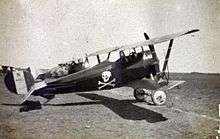Nieuport 24
| Nieuport 24 and 24bis | |
|---|---|
 | |
| Nieuport 24 C.1 | |
| Role | fighter / advanced trainer |
| National origin | France |
| Manufacturer | Nieuport |
| Designer | Gustave Delage |
| First flight | 1917 |
| Status | retired |
| Primary users | Aéronautique Militaire Royal Flying Corps Royal Naval Air Service |
| Developed from | Nieuport 17bis |
| Variants | Nieuport 27 |
The Nieuport 24 was a French sesquiplane fighter aircraft during World War I designed by Gustave Delage as a replacement for the successful Nieuport 17. In the event its performance was little better than the type it was meant to replace, which was largely superseded by the SPAD S.7 instead. Operational Nieuport 24s served with French, British and Russian units, and the type also served widely as an advanced trainer.
Design and development
The Nieuport 24 introduced a new fuselage of improved aerodynamic form, rounded wingtips, and a tail unit incorporating a small fixed fin and a curved rudder. The tailskid was sprung internally and had a neater appearance than that on earlier Nieuports. A 130 hp Le Rhône rotary engine was fitted.
There were initial structural problems with the new tail, and most production aircraft of the type were of the Nieuport 24bis model, which retained the fuselage and wings of the 24, but reverted to the Nieuport 17 type tailplane, tailskid and rectangular balanced rudder. The new tail was finally standardised on the Nieuport 27.
A batch of Nieuport 24bis were built in England for the Royal Naval Air Service.
The standard armament of the Nieuport 17 (a synchronised Vickers in French service - a Lewis gun on a Foster mounting on the top wing in British service) was retained to save weight and retain a good performance, although many 24s were used as advanced trainers and normally flown without guns.
Service history

In the summer of 1917, when the Nieuport 24 and 24bis. were coming off the production line, most French fighter squadrons were replacing their Nieuport 17s with SPAD S.VIIs – and many of the new fighters went to fighter training schools, and to France’s allies, including the Russians, and the British, who used theirs well into 1918, due to a shortage of S.E.5as. A few French units retained the Nieuport through late 1917 – the type was actually preferred by some pilots, especially the famous Charles Nungesser.
Some of the large number of Nieuport advanced trainers bought by the Americans for their flying schools in France in November 1917 were 24s or 24bis.
Variants
- Nieuport 24
- single seat fighter
- Nieuport 24bis
- similar to 24 but used earlier metal tail with a comma shaped rudder and an angular horizontal tail.
- Nieuport 27
- development of 24 with pivoted tailskid.
- Nakajima Ko-3
- Japanese built version of the Nieuport 24.
- Nieuport B.Kh2
- Siamese designation for Nieuport 24bis.
Operators
- Afghan Air Force - A single Nieuport 24 fighter was donated by the Soviet Union in September 1921, as part of the initial equipment of the Afghan Air Force, along with a Farman HF.4 and a Sopwith 1½ Strutter. It still existed in December 1924.[1]
- Bulgarian Air Force - One captured 24bis, formerly N4487
- Estonian Air Force - Postwar.

- Latvian Air Force - Postwar.
- Polish Air Force - ex-Russian aircraft
- Imperial Russian Air Service - some built in Russia
- Yugoslav Royal Air Force - Postwar
Specifications (Nieuport 24bis.)
Data from
General characteristics
- Crew: One
- Length: 5.88 m (19 ft 3½ in)
- Wingspan: 8.18 m (26 ft 10 in)
- Height: 2.44 m (8 ft)
- Empty weight: 354 kg (782 lb)
- Loaded weight: 544 kg (1,200 lb)
- Powerplant: 1 × Le Rhône 9J Rotary engine, 90 kW (130 hp)
Performance
- Maximum speed: 187 km/h (116 mph)
- Range: 249.44 km (155 miles)
- Service ceiling: 5,550 m (18,200 ft)
- Rate of climb: 3.78 meters per second (745.45 feet per minute)
Armament
- Guns:
- (French service) 1 × synchronised Vickers machine gun
- (British service) 1 × Lewis gun on Foster mounting on upper wing
See also
- Related development
- Nieuport 17
- Nieuport 27
- Redfern Nieuport 17/24, replica for amateur construction
Notes
- ↑ Andersson Air Enthusiast May/June 2003, p. 20.
- ↑ Историја. "Нијепор 24". Vazduhoplovnetradicijesrbije.rs. Retrieved 2014-02-05.
- ↑ Bruce 1982, p. 336.
References
| Wikimedia Commons has media related to |
- Andersson, Lennart. "Turbulent Origins: The First 30 Years of Aviation in Afghanistan". Air Enthusiast, No. 105, May/June 2003. pp. 19–27. ISSN 0143-5450.
- Bruce, Jack M. "More Nieuport Classics". Air Enthusiast, Number Five, November 1977-February 1978. Bromley, Kent, UK: Pilot Press. pp. 14–28.
- Bruce, J.M. The Aeroplanes of the Royal Flying Corps (Military Wing). London:Putnam, 1982. ISBN 0-370-30084-X.
- Bruce, J.M. (1994). Nieuport Fighters - A Windsock Datafile Special Volumes 1 & 2. Herts, UK: Albatros Publications. ISBN 978-0948414541.
- Cheesman E.F. (ed.) Fighter Aircraft of the 1914-1918 War Letchworth, Harletford Publications, 1960 pp. 96–97
- Cooksley, Peter (1997). Nieuport Fighters In Action. In Action Aircraft Number 167. Carrollton, TX: Squadron/Signal Publications. ISBN 978-0897473774.
- Franks, Norman (2000). Nieuport Aces of World War 1 - Osprey Aircraft of the Aces 33. Oxford: Osprey Publishing. ISBN 1-85532-961-1.
- Janić Č, Petrović O, Short History of Aviation in Serbia, Beograd, Aerokomunikacije, 2011. ISBN 978-86-913973-2-6
- Kowalski, Tomasz J (2003). Nieuport 1-27. Lublin: Kagero. ISBN 978-8389088093.
- Sanger, Ray (2002). Nieuport Aircraft of World War One. Wiltshire: Crowood Press. ISBN 978-1861264473.
- Taylor, John W. R., and Jean Alexander. "Combat Aircraft of the World" New York: G.P. Putnam's Sons, 1969 Pg.115 Library of Congress Catalog Card Number 68-25459